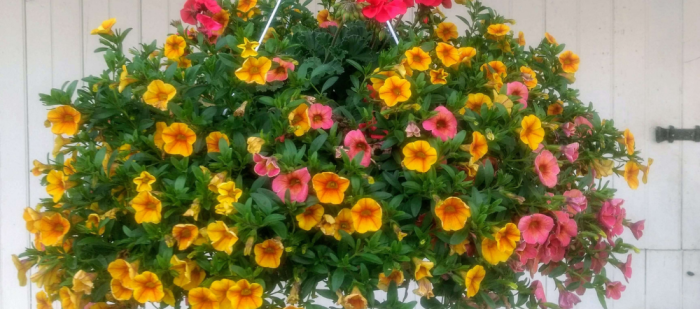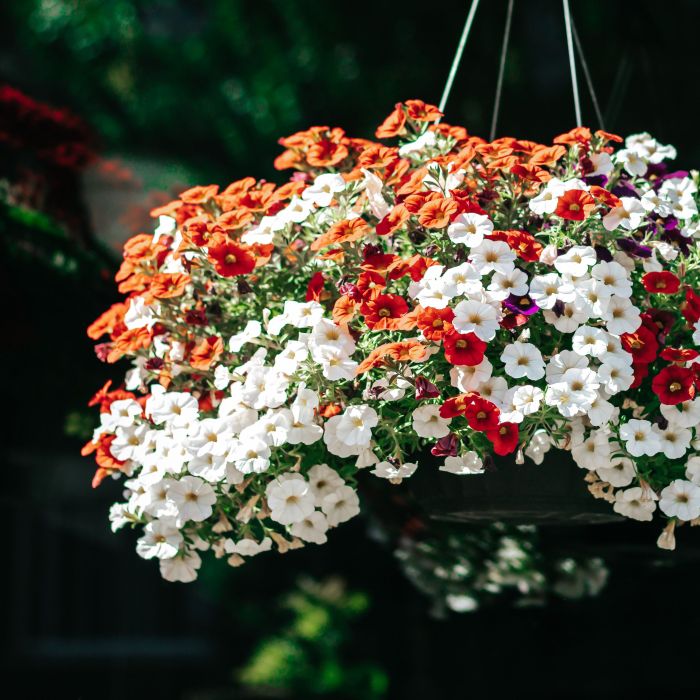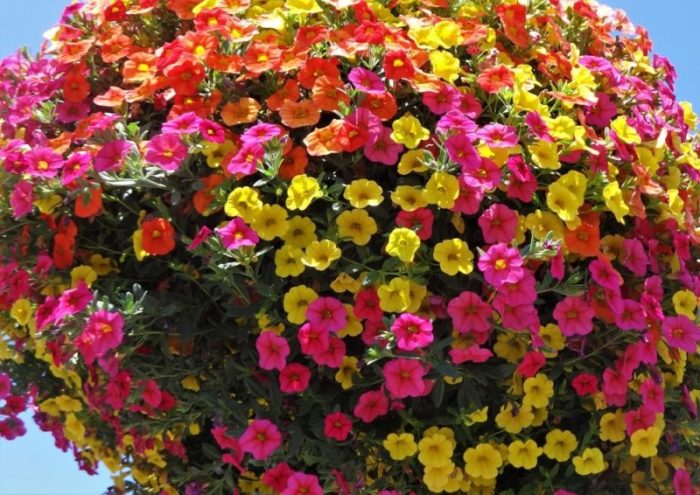Hanging basket plants that don’t need sun are a gardening game-changer, offering lush greenery and vibrant blooms even in the shadiest corners. Discover the enchanting world of these low-maintenance wonders and transform your outdoor space into a thriving oasis.
From trailing ivy to cascading ferns, we’ll explore a diverse range of shade-tolerant species, their unique characteristics, and the secrets to keeping them flourishing in limited sunlight.
Suitable Plant Varieties

Hanging baskets can add a touch of greenery and color to shady areas of your home or garden. Here are some of the best hanging basket plants that thrive in shaded areas:
Fuchsias
- Fuchsias are known for their beautiful, bell-shaped flowers that come in a variety of colors, including pink, purple, red, and white.
- They prefer moist, well-drained soil and should be watered regularly.
- Fuchsias grow best in temperatures between 55 and 75 degrees Fahrenheit.
Impatiens
- Impatiens are a popular choice for hanging baskets because they are easy to grow and bloom profusely.
- They come in a wide range of colors, including pink, purple, red, white, and orange.
- Impatiens prefer moist, well-drained soil and should be watered regularly.
- They grow best in temperatures between 60 and 80 degrees Fahrenheit.
Begonias
- Begonias are another good choice for hanging baskets because they are relatively low-maintenance and bloom for a long period of time.
- They come in a variety of colors, including pink, red, white, and yellow.
- Begonias prefer moist, well-drained soil and should be watered regularly.
- They grow best in temperatures between 60 and 75 degrees Fahrenheit.
Ferns
- Ferns are a great way to add a touch of greenery to your hanging baskets.
- They come in a variety of shapes and sizes, so you can find one that will fit your needs.
- Ferns prefer moist, well-drained soil and should be watered regularly.
- They grow best in temperatures between 55 and 75 degrees Fahrenheit.
Coleus
- Coleus is a colorful plant that is known for its variegated leaves.
- It comes in a wide range of colors, including pink, purple, red, and green.
- Coleus prefers moist, well-drained soil and should be watered regularly.
- It grows best in temperatures between 60 and 80 degrees Fahrenheit.
Vertical Gardening Techniques

Hanging baskets are not limited to patios and balconies; they can also be used indoors to create lush vertical gardens. Vertical gardening maximizes space and adds a touch of greenery to any room.
There are several vertical gardening methods suitable for hanging baskets. Trellises, hooks, and macrame hangers are popular options that provide support and allow plants to grow upwards.
Using Trellises
Trellises are vertical structures that provide support for climbing plants. They can be made from various materials such as wood, metal, or plastic. Trellises can be attached to the wall or ceiling, or they can be free-standing. Climbing plants, such as ivy or clematis, can be trained to grow up the trellis, creating a beautiful vertical display.
Using Hooks
Hooks are another simple and effective way to create a vertical garden. Hooks can be screwed into the wall or ceiling and used to hang baskets at different heights. This method is ideal for plants that trail or cascade, such as ferns or spider plants.
Hooks can also be used to create a staggered effect, with baskets hanging at varying heights.
Using Macrame Hangers
Macrame hangers are a stylish and versatile way to hang baskets. Macrame is a type of knotting that can be used to create intricate and beautiful patterns. Macrame hangers can be made from a variety of materials, such as cotton, jute, or hemp.
They can be hung from the ceiling or from a hook on the wall. Macrame hangers are ideal for plants that trail or cascade, as they allow the plant to hang freely.
Creating a Cascading Effect
Trailing plants can be used to create a beautiful cascading effect in hanging baskets. To create this effect, choose plants with long, trailing stems, such as ivy, spider plants, or ferns. Plant the trailing plants in the center of the basket and allow the stems to cascade over the sides.
You can also use hooks or macrame hangers to create a staggered effect, with baskets hanging at varying heights.
If you’re looking for low-maintenance greenery to add some life to your outdoor space, consider hanging basket plants that don’t need sun. These plants are ideal for shaded areas or balconies with limited sunlight. Explore a wide selection of outdoor hanging basket plants at B&Q ( outdoor hanging basket plants b&q ). From ferns and begonias to trailing ivy and spider plants, there are plenty of options to choose from that will thrive in shady conditions, adding a touch of greenery to your outdoor haven.
Watering and Fertilizing: Hanging Basket Plants That Don’t Need Sun
Hanging basket plants that thrive in shady conditions require careful watering and fertilizing practices to maintain their health and vigor. Understanding the specific needs of each plant species and adjusting the care routine accordingly is essential.
Proper drainage is crucial to prevent waterlogging, which can lead to root rot. Choose hanging baskets with drainage holes and use a well-draining potting mix. Avoid overwatering, especially during cooler months or when the plants are not actively growing.
Watering Schedule
The watering schedule should be tailored to the specific plant species and the environmental conditions, such as temperature, humidity, and sunlight exposure. In general, water the plants when the top inch or two of soil feels dry to the touch.
During hot, dry weather, plants may require more frequent watering. Conversely, during cooler months or when the plants are dormant, watering should be reduced.
Fertilizing
Fertilizing hanging basket plants regularly provides essential nutrients for healthy growth and blooming. Use a balanced liquid fertilizer diluted to half strength and apply it according to the manufacturer’s instructions.
Fertilize the plants every two to three weeks during the growing season, from spring to fall. Avoid fertilizing during the winter months when the plants are dormant.
When choosing hanging basket plants that don’t need sun, it’s important to consider their specific care requirements. For a comprehensive guide to hanging basket plant care , visit our website. By following these guidelines, you can ensure that your hanging basket plants thrive, even in low-light conditions.
Pest and Disease Management
Hanging basket plants that don’t need sun are susceptible to various pests and diseases that can affect their health and appearance. It’s crucial to identify these issues early on and take appropriate measures to prevent or control them.
Common pests that can infest hanging basket plants include aphids, spider mites, whiteflies, and mealybugs. These pests can cause damage by sucking sap from the leaves, stems, or flowers, leading to stunted growth, yellowing of leaves, and reduced flowering. Diseases such as powdery mildew, botrytis blight, and root rot can also affect these plants, causing discoloration of leaves, wilting, and rotting of roots.
Hanging basket plants that don’t need sun are a great way to add some greenery to your home without having to worry about finding a sunny spot. For those looking for winter hanging basket plants, winter hanging basket plants b&q has a wide selection of plants that can withstand the colder temperatures.
These plants are perfect for adding a touch of color and life to your home during the winter months. Some popular hanging basket plants that don’t need sun include ferns, pothos, and peace lilies.
Pest Control
To prevent and control pests, regular inspection of plants is essential. Remove any visible pests manually or use insecticidal soap or neem oil to kill them. For severe infestations, consider using chemical insecticides specifically labeled for use on indoor plants.
Disease Prevention, Hanging basket plants that don’t need sun
Preventing diseases in hanging basket plants involves providing proper growing conditions, including adequate air circulation and avoiding overwatering. Remove any diseased plant material promptly to prevent the spread of infection. If necessary, use fungicides labeled for use on indoor plants to control fungal diseases.
Aesthetic Considerations

When selecting and arranging hanging basket plants that thrive in shade, aesthetic considerations play a vital role in creating visually appealing displays. From choosing complementary colors to combining contrasting textures, careful planning ensures a cohesive and visually stunning result.
Designers emphasize the importance of considering the overall visual impact of the hanging baskets, taking into account the shape, size, and style of the baskets themselves. The goal is to create a harmonious balance between the plants and their containers.
Color Combinations
Color combinations can significantly enhance the visual appeal of hanging baskets. Selecting plants with contrasting colors, such as vibrant reds and deep greens, creates a striking and eye-catching display. Alternatively, monochromatic schemes, featuring different shades of the same color, can create a more subtle and sophisticated look.
Plant Textures
Combining plants with varying textures adds depth and interest to hanging baskets. Smooth-leaved plants, such as ferns, contrast beautifully with plants that have textured or variegated leaves, such as hostas or begonias. The interplay of different textures creates a dynamic and visually appealing display.
Overall Visual Appeal
Achieving a cohesive and visually stunning display involves careful arrangement of the plants within the hanging basket. Taller plants should be placed in the center or at the back, while shorter plants can be placed around the edges or in the front.
This creates a sense of depth and visual interest.
Epilogue

Whether you’re a seasoned gardener or a novice seeking to add a touch of nature to your shaded areas, this guide to hanging basket plants that don’t need sun will empower you to create breathtaking vertical displays that will enchant all who behold them.
Essential Questionnaire
Can hanging basket plants survive without any sunlight?
While most plants require some sunlight, there are several shade-tolerant species that can thrive in hanging baskets with minimal direct sunlight.
How often should I water hanging basket plants?
Watering frequency depends on the plant species, but a general rule is to water when the top inch of soil feels dry to the touch.
What are some common pests and diseases that affect hanging basket plants?
Common pests include aphids, mealybugs, and spider mites, while diseases can include powdery mildew and root rot. Regular inspection and prompt treatment are crucial.